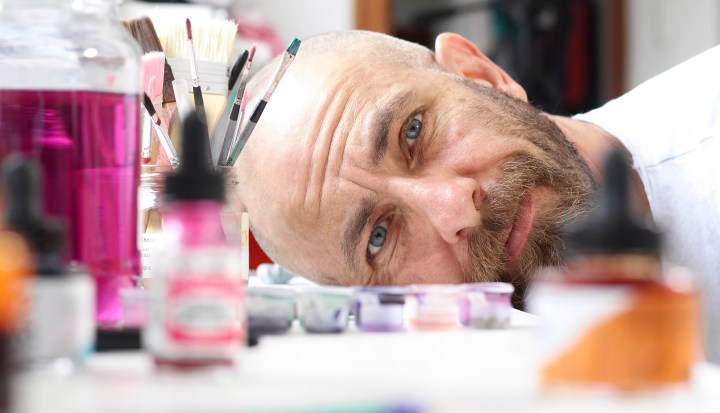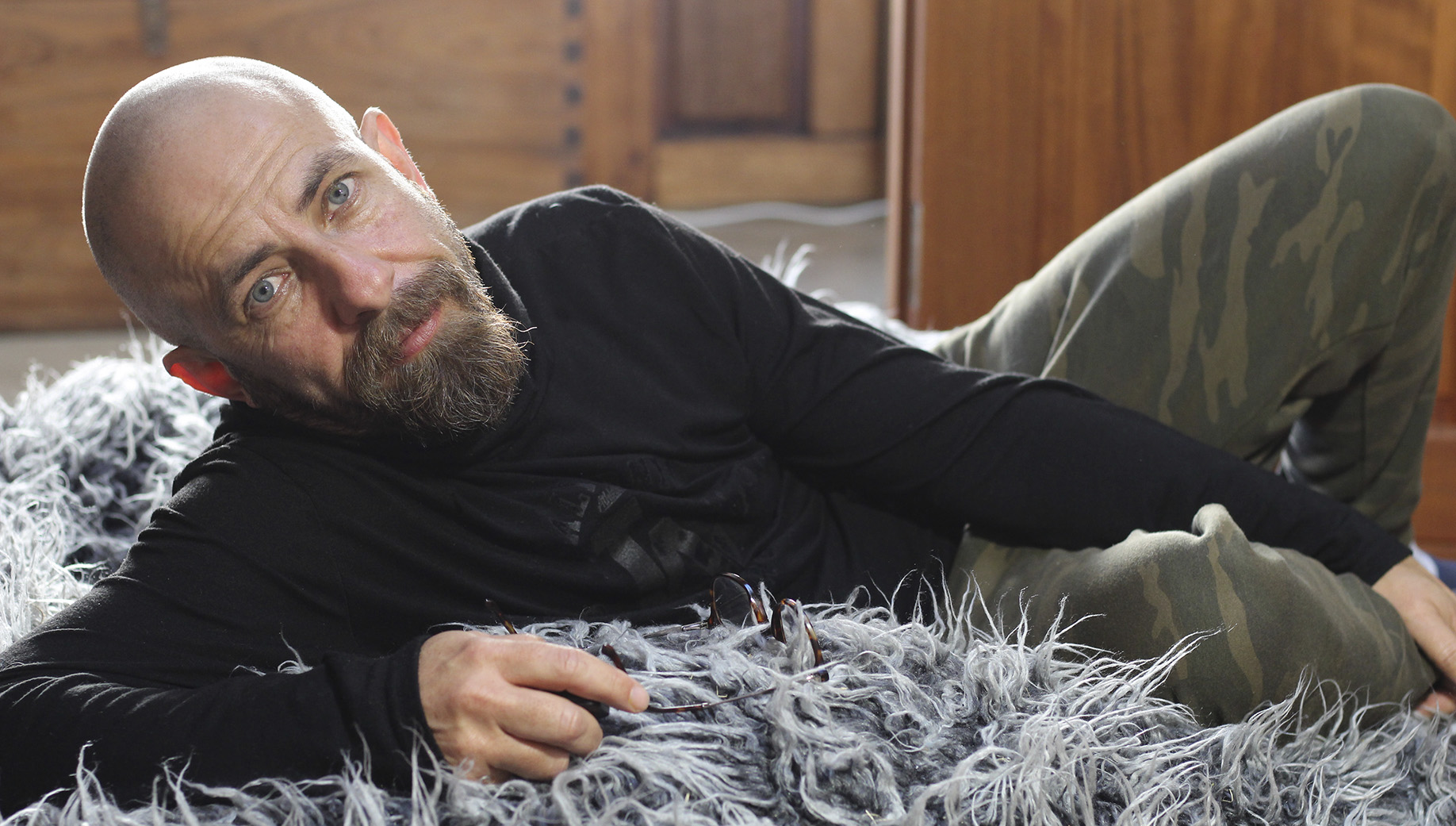A Queer and Crooked Memory
‘We are all petrified.’ An interview with Robert Hamblin

The photographer, painter and writer is 52 and has lived as a man since his 30s. He has grappled with what gender means since he was very young.
Robert Hamblin doesn’t want me to ask him whether he has a penis.
“My body is off limits. If you want to know what happens to trans people’s bodies then go and open the internet. Unless you buy me dinner and a drink. Isn’t that how it’s always preceded?”
We have only just clapped eyes on one another and I’m still trying to work out where to sit.
 It occurs to me then that I am, perhaps peculiarly, uninterested in his genitals. I have read his book Robert: A Queer and Crooked Memoir for the Not So Straight and Narrow in which he demonstrates — generously, warmly, amusingly, poignantly — all the various things that might be called “interesting” about him, and they are so many and so varied that I’ve forgotten to wonder how he pees.
It occurs to me then that I am, perhaps peculiarly, uninterested in his genitals. I have read his book Robert: A Queer and Crooked Memoir for the Not So Straight and Narrow in which he demonstrates — generously, warmly, amusingly, poignantly — all the various things that might be called “interesting” about him, and they are so many and so varied that I’ve forgotten to wonder how he pees.
This is unusual, it seems. While people don’t generally ask one another what their genitals look like, non-trans people — in other words, cisgender people, or people whose sense of their personal identity and gender corresponds with the sex they were assigned at birth — seem to think that being transgender means you’ll willingly discuss how you urinate or climax with anyone who asks.
Hamblin has a rule about how long you’re allowed to pick up and hold your phone in a conversation in order to find something you’ve just referenced and, if you haven’t found what you need within three tries, you find it later and send it on, but it takes less than five seconds for him to find me his favourite joke about cis strangers. It demonstrates how conversations with them usually go. “Lovely weather we’re having,” is the first thing they say, followed by “What’s your name?” and “What do you do for a living?” and then, bam, “Genitals?”
It seems fitting that he introduces “the problem of the penis” into the interview before we begin. Introducing the absurdity of cis prurience into a conversation is a way of asserting some control over one’s own story.
Curiosity is human, of course. Hamblin later says: “We are all curious about other people’s bodies.”
And his book certainly addresses curiosities I didn’t even know I had. For instance, I was interested to learn that since being trans is inherently about “not belonging” in the gender you’ve been assigned, undergoing transition does not deliver one wholly and happily into belonging to the social group of the gender you’ve supposedly joined. Unlearning the socialisation that’s been ground into us is not relief granted anyone through medication or surgery.
Reading Robert has given me the most embodied sense of what “gender is a social construct” means. How are people with vaginas women, or those with penises men? What does it mean to be a man? Or a woman?
Hamblin makes the body personal, direct, vivid, inescapable, infuriating, delightful, terrifying, flexible and funny. And if you don’t understand how complex, how utterly ridiculous, the idea of the male/female binary is when you’ve finished reading the book, then you probably never will.
Robert did make me curious, but not about what’s in the writer’s pants. What I wanted to know was: is the author as quick and warm and funny and busy and insightful and vulnerable and fuck-you in real life as he is on the page?
Yes. Yes, he is.
For two-and-a-half hours he is unflagging in his energetic engagement with every topic I bring up and every question I ask. He is one of those people who says some words in what sounds like capital letters. He moves seamlessly between his mother tongue, Afrikaans, and English, his cursing is amusingly florid, and his laughter unrolls effortlessly.

“What people call politically correct language is really just a series of departure points for kindness.”
(Photo: Georgia Shackleton)
We’re in the heart of his Muizenburg house, where his painting studio is. There’s another studio, outside, that is dedicated to photography. This room has three doors leading off it, one into the kitchen and living area, one into the main bedroom, which he shares with his wife, and one towards the front door of the house.
The room is lit by a skylight into which unusually warm winter air flows. The walls are hung with paintings: finished, half-finished, framed, unframed. Most are his, but some are by other artists, and some belong to his daughter and her friends. There are large photographs from previous exhibitions. There are small photographs of his wife’s family on the antique dresser where two enormous monitors stand, one splattered with blue-green ink, an accidental addition his daughter introduced and which he decided to keep.
A hairy figure on an easel opposite the small teal chair I’ve chosen is still only a black outline except for a blood-red slash at the bottom of the torso.
Hamblin moves a lot. He has parked himself on a large, fluffy beanbag on the floor, where he lounges. This makes me feel like we’re buddies. He clearly does not feel the need to control the power in the room by being eye-level or higher than me. He often jumps up to show me something. One of these moments is sparked by a question about children.
He rockets out of the beanbag to show me a large painting his six-year-old daughter and two of her friends, who hung out at his place most days during lockdown because their parents were freelancers, did. He unrolls a large piece of expensive art paper to reveal an abstraction that curiously comes together when he hangs it “the right way up”. Then he stands back to demonstrate, his entire body involved in the story, how one girl reacted when he asked them how they knew when to stop painting. He shows, using his left arm, how she carried on painting while her body was turned towards him to explain that: “We just paint and chat and then we stop and go outside and play.”
It’s not a funny story on the page. The drama and laughter are in the enactment.
Drama.
Robert, Hamblin’s compelling memoir, is full of life drama. Real, horrible ache-y stuff — not least of which is the story of his connection with his ’80s Dynasty-soap-opera-loving gay father, who triumphed over dangerous verkrampte last-century attitudes towards homosexuality by his wits but who was felled by Aids.
The book is also peopled with all kinds of amusing drama llamas, from religious straight cis men to jealous lesbians.
But the most poignant drama, in the context of a trans man’s life story, is the one when Robert’s girl version camps up an impromptu stage act of being a seductive woman, to the delighted amusement of the children watching. The hyperfeminine performance steals the show from the other actors and fleeting access is gained to a group that usually moves around gender-confusing spectre of his child-self like he is a boulder in a river: on one side the girls who see someone too much like a boy, on the other, boys who see a girl.
Hamblin is 52 now and has lived as a man since his thirties. He has grappled with what gender means since he was very young. I wonder aloud about the extent to which all body dysmorphia and less devastating body-related dysphorias might be related to ideas constructed by society about how bodies should behave in the world, even those experienced by cis people.

As an artist, having pain and showing it is part of the job, say Hamblin.
(Photo: Georgia Shackleton)
“A theme that often comes up in sci-fi is technology and organic things becoming combined and I think often that bodiliness and the systems within which we live are like that. We think that nature and nurture are two separate things, but the systems we live in and the experiences we have become ingrained, and they twist (the way we perceive) our bodies.
“I cannot speak for all people or all trans people, but I do think that fashion, even when it transgresses gender, still dictates how our bodies should or shouldn’t be. And if you don’t have that body, or when things acquire meaning — like big breasts mean this, short legs mean that, a big ass means another thing — the body gets assigned all these meanings and if you don’t feel it obviously you’re going to have a disconnect.
“So, yes, I think maybe we do all have some of it, but we don’t all diagnose ourselves. We just put on our Woolies clothes and bear it.”
Does he still have dysmorphia? The answer is not immediate.
“Um. Er. No.”
Does that have to do with being 50?
“It’s got to do with being older, yes, but it’s also got to do with this examined life.
“I had to face dysmorphia and if I could not supposedly ‘heal’ myself of it I wouldn’t have had access to the medical stuff. In order to transition, you firstly have to understand what is supposedly wrong with you, be diagnosed, to access treatment. Then you are expected to show you have a grip on gender. Then, even though you know you’re not going to get your shit together before you are treated, which is what will let you get your shit together, you learn how to perform that gender, and that was a good rehearsal towards understanding the difficulty of gender. That understanding brought the healing.
“It’s quite a shock to come through that treatment. You’ve run the gauntlet and you’re on the other side and now you just have to worry about the dog’s food and getting milk for your Post Toasties and life is just so real,” he says, stretching out the last words to emphasise, perhaps, lack of heightened emotion in the prosaic and a touch of welcome boredom.
I ask Hamblin about language. People who do not actively engage with the gender debate often feel lost in the language of gender and sexuality and irritated by the issue of pronouns. Robert is a book that avoids academic language and the reader experiences the speaker learning to express himself, not just physically, but also in appropriate language, as he develops. He shares how he fumbles towards his identity in the only language that was available to him at the time, giving permission for readers to be brave about adjusting their own language.
“We are all petrified,” he exclaims, when I say people are afraid of getting the language of a revolution wrong.
Hamblin is uncompromising in his insistence on a clear political stance and is merciless, by his own accounting, to people who refuse to be sensitive, who tell off-colour jokes, ask rude questions or dismiss the gender shake-up. And yet, throughout the interview, he consistently demonstrates a deep compassion for others.
“Look,” he says, speaking in a measured, less ebullient way now, “I lived through the time when I had to teach people to use masculine pronouns for me before I’d had any physical changes and it was a really difficult, really painful time for all of us — and this was before it was all over the internet. I really understand the pain of it. And just as we all started getting used to it, the non-binary movement came along. And they came up with the pronoun ‘they’. I’d learnt from my academic friends that language is everything, that it’s the departure point for changing the world. But then I had to start calling people ‘they’ and, yoh, that was hard.
“It’s hard in the first place because you’re pulling apart something fundamental. The first lesson you learned in how to be human was “you are a girl” and “you are a boy” and you treat tannies like this, and ooms like that, and if you don’t get it right you can lose all your power.
“Gender — pronouns — are the fundamental survival strategy you are taught in the colonised world. Fundamentally grasping that gender is a survival strategy is what keeps you safe. You can get killed for getting it wrong. And here we are now unpicking it and someone — someone vulnerable — is asking you to fuck with a basic survival strategy by asking you to use a pronoun for them you aren’t used to.
“They might seem arrogant to you to be asking it at all, but they’re actually supremely vulnerable. And suddenly you are also vulnerable, because you are being asked to let go the guy ropes of your survival strategy. Or at the very least loosen them.
“And suddenly, in that moment, when someone asks you to use a certain pronoun, we’re all off balance. It’s difficult. No one has even pulled out a knife and everyone feels like they’re about to die.
“We live with constructed fantasies and narratives and this gender one feels so important. So fight or flight is people’s response.
“I was lucky to once go to a conference where we were instructed to refer to everyone there as they and them. It took a day and then it was suddenly easy enough. It’s about practice and if you don’t have gender non-binary people in your life to practice it on, practice it on people around you. And see how lovely it is to de-genderise stuff!
“If you understand gender, you will understand that pronouns are a way of giving someone humanity. And when you misgender someone, you take away their humanity.
“To learn is not a comfortable thing. It’s painful, because you’re redirecting your neural pathways. It’s all about working towards kindness.”
If someone tells you you’ve misgendered them, or you’ve used an inappropriate word, the kind way to respond is not to tell them to stop being sensitive, he adds.
“I think one good way to go about life is to learn to lean outwards. Here is the circle of crisis in the middle,” Hamblin explains, using his hands and body to demonstrate what he means, “and there are all kinds of support that ring out around it. When the person in the middle needs your support, you don’t lean in towards them for support.
“For instance, if someone’s life partner has just died, you don’t begin to wail and sob on their shoulder and tell them how you don’t know how to carry on. You say: what can I do for you? Then you lean outwards. You don’t dump your pain on the person at the centre of the crisis. Go process your shit at home.
“If someone asks you to use a different pronoun to the one that comes naturally to you, they are probably having more of a crisis than you are, so go process your shit at home.
“Another thing is to look at impact and not intent. If you have hurt or offended someone accidentally, the only thing to do in that moment is to say sorry and to move on. You don’t have to go into a whole thing of saying the other person mustn’t be so sensitive and you didn’t mean to offend them and blah-blah-blah. You just say sorry, and you move on and you try harder. Also, don’t do a whole drama about how wrong you were and how sorry you are and beg forgiveness. Because that’s also a kind of disruption. So if you misgender someone, don’t make a fuss, just say I’m sorry, and move on. Process at home and try to do better.”

‘We are all curious about trans people’s bodies because we know we can’t assume the usual things. We want to know what it feels like to escape the power of socially assigned meanings to our limbs, and especially to the fun bits. When people ask, I joke around and ask them to at least buy me dinner first.’ (Photo: Georgia Shackleton)
I have to excuse myself for a minute and when I return to the studio, I find Hamblin painting. “Here,” he says, offering me a small piece of Fabriano art paper. “Do you want to paint?” I can’t paint, but I pick up a brush and dab it in some blue ink.
“Let’s talk about children,” he says.
“What about children?” I ask.
He asks me about mine. I tell him.
“Why do you really want to talk about children?” I ask him.
“Because I want to talk about trans children.”
This topic comes up at least weekly on a huge South African Facebook parenting group I belong to: questions about what schools should and shouldn’t be discussing with pre-teens about sex and gender, gender-neutral school toilets, parents requesting guidance after their children have declared themselves trans, and whether trans is a passing fad come up as regularly as clockwork. A few of the hardworking trans and queer parents are exceptionally thoughtful and patient about explaining the same things over and over again. I wasn’t planning to talk about trans children, but this strikes me as a good direction for the interview to go in.
Hamblin tells me that, since becoming a parent, he has had more understanding for his mother who, he says, has always had a good instinct when it comes to any binary system and who has been “consistently present” despite the many tumultuous years in their relationship.
“Your own child’s body is a sublime thing, and you are responsible for it every day and you have to help it survive to the next day. Our understanding of what it means to be trans is a threat to that and your first response, as a parent of a trans child, is obviously going to be overprotective.
“What you forget if you are an adult in the life of a trans person– and now I’m going to preach — is that the whole world is going to tell your child they’re wrong. So, you have to find a different role to play in your child’s life. Know that there is a path in front of them and you have to walk that path with them, every fucking step, with love.
“Experts will tell you that children who have the most information about sex are least likely to get pregnant. It’s an absolute fact that children who have more information have fewer rash responses to difficulty. So you have to be there with your child, helping them make their choices without them having to navigate your resistance as well. Resisting a child’s path won’t change it. It will just give you a dysfunctional child who will have to pursue their own lonely path as an adult.”
What does he say to people who say being queer is a fashion right now?
“I say: so what?”
But they would say, if it’s going to go out of fashion you shouldn’t mess around with hormones for a trend.
Hamblin laughs. It’s the quietest laugh of the morning. Actually, it’s not really a laugh at all.
“If they only knew how hard it was to get to that first hormone injection. And that’s another thing I’d like to say to people: do not be your child’s gatekeeper, because there are a hundred other people who are going to do the gatekeeping. There is all this first-class care out there: well-researched, scientific support to help your child medically. You just need to seek out that help for your child. No one is in a better position to help them get the best care possible than you are. You would do it for any other condition they might have, so why not for this?”
A condition?
“Yes. It is a medical condition. If it wasn’t, if we didn’t have a diagnosis, we wouldn’t be able to get medical access. It’s controversial and it’s a continued debate among trans activists and healthcare workers, but it’s not verboten to call it a condition.
“Anyway, none of these things have fast rules. If your child has a need to explore identity, you both have to figure out where on the spectrum they are, or if they are just being beautifully swept up in the gender revolution … I mean, wow, what an opportunity.”
I tell Hamblin that his no-holds-barred, frank engagement with his identity in the book seems to come from a place of steady ego, that shame does not play as big a role for him as it does with so many children who come from far more conservative homes or communities than he did. He disabuses me firmly.
“I didn’t want to talk about my body shame anymore, because you know how people internalise racism? Well, people internalise transphobia, too. The chapters in the book where I write about shame are so short. The stuff about cutting myself and where I spoke about having too much weight: those were long years, but I skirted over them. I spent time on sex. On youth. On my father’s vulnerability. But the stuff where my shame was, yoh, I wrote over that very quickly. I mean it’s still powerful, but it is part of my narrative to pretend that there is no shame, while here in my personal life, my wife has had to navigate that with me.
“I can’t languish in shame,” he says. I hear, “I can’t language in shame”, which feels oddly appropriate.
“It sometimes means that I don’t have enough empathy for myself. Or I don’t process things, because I’m too ashamed to have shame.”
And yet.
Here Robert Hamblin is, apparently confidently, hair-ily and happily inhabiting his male body in a sweet little suburban house, with his wife working in the next room and his daughter at creche. He’s had an exceedingly successful life as a photographer and now as a painter. He has written a book that will, I have no doubt, change the way many readers understand what it means to be transgender by putting them right inside another body using the magic of words. Shame is part of the story, but it hasn’t stopped him from living out loud.
How did he get to be such a straight shooter? Is it because the Joburg gay scene of the ’80s was often rough and cruel, a response to the environment of oppression and fear? Is it because he was a newspaper photographer and newsrooms were notoriously hardcore about no bullshit?
“Look, I am an artist. It is my duty to make a book or a painting. Having pain and showing it is part of my job.”
But writing Robert was not a walk in the park. Hamblin was part of the Life Righting Collective, run by the prolific writer Dawn Garisch, who is also a GP and believes strongly in the healing power of writing. Whenever Hamblin’s writing wandered towards the cerebral, towards “cleverness”, she yanked him back and told him to “just tell us what happened”.
“The book traumatised me … to revisit all those things. Because I was in it all over again. I wasn’t an adult looking back. I wrote from inside the child, the teenager. I had to go there, be that person again. So, no, it wasn’t healing while I was doing it.
“Dawn always says that to survive as a human you need an anxiety management plan, and a very important part of any human’s anxiety management plan is talking. Some people pay someone so they can talk. Some families have a culture of talking. Some of us write.
“We are all storytellers. And part of mental health is to be able to tell your own story. Because to tell your own story is to take back power.
“There is also this idea that the ultimate acknowledgement of your life is a book or a movie about you; that you write a book and it’s all glory and it heals everything. Well, it fucking doesn’t.”
He pauses from daubing bleach off the paper he has been working on and stands back.
“But in the end,” he says, shrugging his shoulders and cocking his head to assess the painting he’s been smudging, “I suppose art does heal us.” DM/MC
Robert: A Queer and Crooked Memoir for the Not So Straight or Narrow by Robert Hamblin is published by Melinda Ferguson Books, an imprint of NB Books. The book will be launched at Nel, 117 Long Street, Cape Town on Tuesday 22 June at 6pm. The same event is also the opening of his debut painting exhibition.



















 Become an Insider
Become an Insider
Beautifully told, both of you. Thank you.
Phew…this subject would have certainly confused things in the Garden of Eden! How complicated life becomes when you have choices! And then the weight of responsibility from the choices you make! Do artists suffer more than ordinary uncomplicated people? Or are they Narcissists who indulge themselves by making choices that cause them pain which they then call art?
This whole convo re trans -gender confusion is exhausting in my opinion…I wonder how we have the time for it when there are much bigger problems in the world…homelessness, joblessness, famine, poverty…..all of them painful, none of them healed by art!
This is an exquisite interview and deeply touching story.
Thank you Robert Hamlin for your courage and Karin Schimke for telling of it so beautifully.